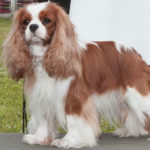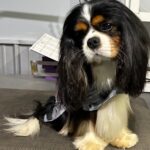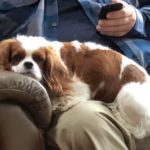Dedicated to the preservation of the Cavalier King Charles Spaniel
About the Breed
History of the Cavalier King Charles Spaniel
The Cavalier King Charles Spaniel as we know it has been around for less than 100 years. Though their ancestors have been noted in historic paintings dating as long ago as 1440 when they were known commonly known as Comfort Spaniels. They were dogs of aristocrats.
The first Cavaliers came to America in the 1952. The breed club was formed in 1956. They received AKC recognition in 1996. The American Cavalier King Charles Spaniel Club was established in 1993 and remains the parent club in this country.
Size
According to the ACKSC standard, adult Cavaliers should weigh between 13-18 lbs. They should stand 12 to 13 inches at the withers and be of moderate bone.
Colors
Cavaliers come in 4 recognized colors; Blenheim (chestnut and white), Tricolor (black, white and tan), Ruby (solid red), and Black and Tan.
Grooming
Though Cavaliers have an elegant silky coat, they do not require a large amount of grooming. Brushing them out once a week or so will help them not to develop mats. It is important that their ears be kept clean as not to allow them to develop infections. Cavaliers that are shown in AKC conformation events must not be trimmed.
Health Concerns
Most would agree that Mitral Valve Disease (hearts) and SM (Syringomyelia) are the most important health issues in our breed, there are more, but these are focus issues. Both MVD & SM are believed to be poly-genetic. The mode of inheritance is not yet really understood, and even researchers disagree. As more is discovered, breeding approaches are changed, over time. Many breeders are addressing these issues by screening and using the information gained to make informed breeding decisions. Please note; even with testing, things can pop up. There are no guarantees in nature. Genetics are just not that simple. We prioritize doing the best we can, with the information we have at the time.
A large percentage of cavaliers will develop MVD to some degree at some point in their life. With testing and selective breeding ethical breeders have made improvements as a whole in our breed over time. MVD has many presentations, and we still have much to learn about it. Many Cavaliers live long full lives and some never even require medication. Some will need medication at some point, usually in their elderly years. These are factors that MUST be considered when getting a Cavalier. 50% of cavaliers have a murmur by age 5. Only 2% are heart clear at age 10. A murmur does not always mean medication, but it does mean a diligence getting screened by a cardiologist and working with one for the remainder of the dog’s life.
SM is estimated to be in 40% to 50% of cavaliers, many will never experience any symptoms but the risks are greater when MRI screening is not done. Though it is an issue in multiple toy breeds, it is a focus in cavaliers. We believe in taking a proactive approach to SM by MRI scanning our breeding dogs. It is our hope that by participating in MRI scanning and making selective breeding decisions over time we can greatly reduce the number of affected dogs in our breed as a whole. We have wonderful mentors in the breed with years of experience helping us with our decisions. Health testing only gives us a snapshot in time when looking at our dogs. With all the changes in the medical testing and discoveries being made (especially with MVD & SM) it is sometimes hard to keep up on all the new information. But for us and our dogs, we have decided this is the direction we desire to proceed in. We have seen big changes in the “science” even since we started this journey.
It is important to purchase your Cavalier from a committed breeder. Every person has to weigh out what is important to them, they should have a whole picture approach to breeding. Breed type, temperament, structure, movement, health testing, longevity in the pedigree… everything must be considered when choosing which two dogs to mate together. Breeders may have different goals and focuses. Hopefully health, longevity and breed standard/type are at the top of that list.
Committed Breeders
There are disagreements among breeders as to the ideal age to breed a Cavalier, but most would agree that female Cavaliers should not be bred before age 2, (or) not before 18 months and their 3rd heat cycle. Health considerations concerning the parents and grandparents also need to be considered.
Most reputable breeders are addressing health issues as best they can by participating in various tests offered for their breeding stock. In our opinion that minimally they should have their Hearts screened annually by a Board-Certified Cardiologist, CERF eye exams should also be done, DNA tests or by parentage to identify carriers of Curly Coat, Dry Eye and Episodic Falling, and MRI’s when possible. It should also be noted that Hips and Patella’s should also be a consideration within this breed.
With all of the testing available there still are no real genetic guarantees. Genetically there is still too much unknown about some conditions and varying opinions and documentation. Environment must also be considered. Quality of food, flea & tick medications, vaccines, other chemical exposures, weight & exercise all play factors in the longevity of any dog.
Health tested parents are a good place to start. Please, be sure to deal with a committed breeder who has an interest in the dogs they have bred. They want to have an overall picture for the future generations. Websites can be deceiving. Visit the home of the breeder, if at all possible. Look for a breeder that takes genetic testing seriously. Otherwise, your less expensive Cavalier will likely cost you a lot more in the long run. By purchasing a puppy from a committed breeder, you are also gaining a mentor and friend who also has a vested interest in your puppy. They are not just breeding puppies, they are planning by doing pedigree research, health research and should have a specific goal for each breeding they do with an overall goal in improving their breeding program. Every puppy matters.
Contrary to popular belief, many breeders do not have both parents on site. When breeders are researching lines and working on breeding goals, they may use stud dogs from other parts of the country or even out of the country. As a breeder you are looking for the best possible match for your girl. You want to select a stud dog with specific qualities. That may include longevity in pedigrees, specific health testing, knowing what improvements your girl needs and looking for the stud you best believe can improve the next generation. Sometimes it’s a wonderful combination, other times it’s not what you hoped for. Again, genetics and mother nature, much is out of our control.
A reputable breeder will work with their puppy families if or when health issues arise. They will be available for questions regarding a variety of issues: health, diet, supplements, and other recommendations. Remember, the breeder you choose should desire to have a vested interest in any puppy they produce. They CAN NOT guarantee your dog will never have an issue. That is just unrealistic. However, they will want to celebrate with you on your victories, and they will mourn with you during disappointment.
In our opinion dealing with a reputable breeder lowers some of the risks through research and testing, but the reality is just like in people, things do come up. A seasoned breeder friend once told me “If you breed enough, long enough, you will see things come up.” We just do not know what will happen when we combine different genes. The best we can do is our best.
Prices
On the average serious breeder prices start at $4000 and go up from there. (Especially if the parent dogs have been MRI’d.) However just because a puppy is expensive it does not mean the breeder is testing for these conditions. Prices of Cavaliers can vary greatly in different areas of the country depending on geographic location & health testing etc. It is common to see them from $4500 – $6500. And some of those are not testing for everything.
Serious breeders will not sell a puppy with an AKC full registration (unless to an approved show home) or will not sell a pet puppy without a spay/neuter contract of some type. This is NOT a breed served well by back yard breeders or puppy mills. The Cavalier gene pool is relatively small. It is critical that not only is health testing is done, but everything is considered with breeding dogs, to ensure the survival and health of the breed overall and not get bottlenecked genetically.
All of our pet puppies are placed on a limited AKC Registration only. We rarely sell a puppy on an open registration. We either register the puppies ourselves on a Limited Registration to the puppy’s adoptive family and/or hold the registration papers until proof of spay or neuter is provided on our puppies. This is for the safety and protection of our puppies. Please ask me why, and I will be happy to share our reasons for this decision. Our first responsibility is to provide our puppies with the best and safest homes possible. We will provide a 3-generation pedigree on every puppy we place.
Whether you choose to adopt a puppy from us or from someone else, please become informed about the breed. If we do not have what you are looking for, please CONTACT US. We know many other reputable breeders who may have what you are looking for.
Jennifer – is an AKC Breeder of Merit.
Kingslee Cavaliers is a member is good standing with Great Lakes CKCSC breed club.
Jennifer has served GLCKCSC in many positions over the years. As the Club Vice-President, Web Design & Media, Breeder Referral, Secretary and active member. She remains an active member.
Please take the time to visit all of our pages.
Read our PUPPY POLICIES
Fill out our PUPPY QUESTIONNAIRE
Xoloitzcuintli
Pronounced “show-low-eats-QUEENT-lee” is derived from the name of the Aztec god Xolotl and Itzcuintli, the Aztec word for dog.


The Dark History of the Xolo
The Xolo is known to be one of the world’s oldest and rarest dog breeds dating back over 3,500 years ago. It is a healthy and robust breed originating from the primitive jungles of Colima, Mexico. Many clay and ceramic artifacts have been found in the tombs of the Mayan, Colima and Aztec Indians. The Aztecs deeply revered the Xolo and thought they possessed healing abilities. in rural parts of Mexico this is still believed today. One reason is they feel warm to the touch and can act as a hot water bottle. Xolos were long regarded as guardians and protectors of the indigenous people. They believed the Xolo would safeguard their home from evil spirits as well as intruders. In ancient times they were often sacrificed and then buried with their owners, thought to be a guide for their soul into the underworld. They were also considered a delicacy and were consumed for sacrificial ceremonies including marriages and funerals.
Xolos first began to appear at Mexican dog shows in the late 1940’s. Though the species was indigenous and a native breed, there was little interest in them. A decade later the FCM realized the breed would become completely extinct if action was not taken to save it. It led to the widely publicized “Xolo Expedition of 1954” led by Norman Pelham Wright. He found and brought back many good Xolos and these dogs formed the foundation of Mexico’s breeding program to save the breed. Wright authored the first official breed standard. First registered in Mexico in 1955, the standard for the breed was adopted in 1956 and the Xolo was recognized in its native land. It is now considered the “Official dog of Mexico”. The Xolo was first registered in the American Kennel Club from 1887 – 1959 as the “Mexican Hairless” breed. It was dropped due to insufficient numbers being bred and registered. The photo in the Mexican Hairless chapter from 1935 Toy Dogs makes it clear that this breed was in no way a true Xolo, simply a hairless Chihuahua or crossbreed.
The Xolo returned to the AKC show ring in 2011 as its 170th breed.
Temperament
They are a primitive breed. All 3 sizes exhibit the typical temperament of a working breed. They are intelligent and learn quickly and bond closely with their owners. They can be sensitive. They are usually reserved or aloof with strangers. Xolos are affectionate and playful with their family members. They should never be timid or aggressive. They are a breed who must receive early socialization and a commitment to training. They are generally a healthy breed with a long lifespan 14 – 17 years. They are considered a watch dog. They are very clean and will often be seen cleaning themselves like a cat. They are generally easy to housebreak. Xolos tend to bond strongly with one family member although they will connect with and love the whole family, including other pets.
Xolo’s come in 3 sizes and many colors
The AKC Standard:
Toy 10-14 inches at the shoulder & weigh 10 – 15 pounds. Perfect size for apartment dwellers that want a lap dog.
Miniature – 14 – 18 inches & 15 – 30 pounds. (pictured below with our standard) They are known as the clown of the breed. They are the ideal size for family pets. Big enough to play with kids but small enough to be scooped up to cuddle on the couch.
Standard is the largest at 18 – 23 inches at the shoulder, 30 – 55 pounds. (pictured below in the hairless and coated examples) They are an impressive guard of the home and family.
In the show ring the solid dark colors are preferred. But a wide variety of coat colors can be seen in the breed. The hairless may have hair on their head, tail and feet. The coated should be covered in a sleek tight-fitting coat.
Hairless & Coated


Many people do not realize that Xolos come in both a hairless and a coated variety. They are frequently referred to as a Mexican Hairless, so it is not surprising people have no idea there is a coated variety within the breed. Genetically even breeding hairless to hairless you will most likely get some percentage of coated in the litter. Breeding coated to coated will produce all coated puppies. Breeders frown on breeding coated to coated specimens. Some breeders will not even utilize a coated dog within their breeding program. For many years the coated Xolo’s were not considered desired. As the breed gains popularity, and people become aware there are coated varieties within the breed they are becoming more and more accepted in the show ring. Our first Xolo was coated. We live in Northern Michigan so getting a coated seemed like the best introduction to the breed. He “Tolo” is one of the best dogs we have ever had. He quickly hooked us on the breed. Personally, we think he is one of the most beautiful, coated Xolos we have ever seen…. but we are probably a little bias.
Dentition
Dentition must be mentioned with this breed. The hairless variety may have missing teeth and/or shallower roots. They can lose teeth earlier. Sometimes they are just missing. It is a genetic factor of the hairless variety and can vary from dog to dog. Coated Xolo’s must have full dentition.
Grooming
Hairless Xolos are easy to groom. (Especially when you consider our primary breed is the Cavalier). When I go to a dog show it takes me 1-2 hours to groom my cavaliers and 5 – 10 minutes to prep my Xolo. The Xolo needs good quality food (good skin from the inside out), bathing monthly and lightly exfoliating is usually sufficient. A simple wipe down with a damp cloth can be done between baths. In the winter months they will require lotion to keep their skin hydrated. Their skin is tough hide vs soft skin. They heal very quickly.
Their nails grow very quickly and must be done very routinely.
Xolos naturally extrude an oil that protects them from the sun and insects. Xolos darken or tan with exposure to the sun. They are prone to adolescent acne but keeping the dog and its surroundings clean helps this stage to pass with minimal amounts of stress.
Health
Thankfully Xolos are a hearty primitive breed and do not exibit the health problems of other domestic breeds. Xolos exibit an average lifespan of 14-17 years.
OFA –
Recommendations for Xolos are based on size. All should have CAER eye exams and Cardiac Exams basic or advanced. Elective- Patella for Toy size and Hip/elbow for Miniature and Standard Size.
















